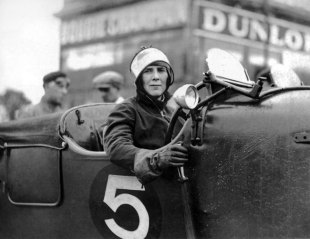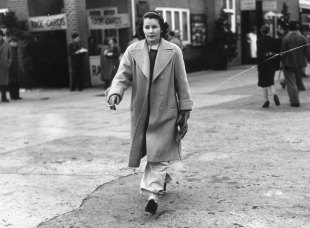
- Drivers:
- Kay Petre
Back in the good old days, when cars were new, corsets were history, and dentists prescribed cocaine for toothache, the concept of automobile racing was still in its infancy, and no one had thought to tell women they couldn't take part.
Moneyed men and women, pumped up with the spirit of adventure, took it upon themselves to test these new machines to the limit, driving them for speed, for endurance, and for distance.
Three of these women - Mildred Bruce, Kay Petre, and Violet Cordery - made the most of the opportunities given to them.
They stared danger in the face, they showed determination to achieve whatever they put their minds to, and they lived their lives to the full. They may be linked by a shared passion for motorsport, but each and every one is an individual worth celebrating in her own right.
Born in 1895, Mildred Bruce began racing motorbikes at the age of 15, and is believed to have been the first British woman ever arrested for speeding, appearing before Bow court in 1911 under charge of operating a motorbike at 60mph. That may not sound like much now, but roads and engines have changed a quite bit in the past century. Bruce was known for haring around the country lanes near Chelmsford on her motorbike, with an excitable Collie sitting in the sidecar.
But it was in the world of automobile racing that The Hon. Mrs. Bruce made her first big impression. She competed in road races across Europe, and secured her place in the record books when she placed sixth overall in the 1927 Monte Carlo Rally, and won the Coupe des Dames. In the same year, she and husband Victor set an endurance record in an AC Six at Montlhery, driving for 10 days.
The two made a good adventuring team until their divorce in 1941. Once the Montlhery endurance efforts were out of the way, the couple drove further north than anyone in human history, taking a 1920s car 400 kilometres north of the Arctic Circle. The Top Gear crew has since beaten the Bruces' record, but their car was somewhat better equipped to deal with the treacherous conditions.
Perhaps the most impressive of Bruce's driving achievements, however, was her work for the Bentley Le Mans team in 1929. She broke in a 4.5 litre beast for the team by driving it around Montlhery for 24 hours prior to the key endurance event, and took the world record for single-handed driving by a woman, posting an average speed of 89mph that has yet to be outdone.
In her lifetime, Mildred Bruce held 17 world records in cars, boats, and planes. She set and broke records for solo flight, for Channel crossings, and speed on track and road alike. In business she was a great success, helping to pioneer midair refuelling in the UK, and running air freight and charter companies that later made her millions.

Related to Mildred Bruce by marriage - their husbands were second cousins - was Kay Petre, the first woman to lap the Brooklands circuit at over 130mph.
Standing only four feet, ten inches tall, and known for driving cars customized with blocks on the pedals to enable her to reach them, Kay Petre was a Canadian ice-skater who moved to England after marriage. Petre spent a lot of time at Brooklands, where her husband made frequent use of the airfield.
But Petre was interested in the activities on track, and the diminutive Canadian was quickly bitten by the racing bug. Desperate to stop his young wife from racing his prized Invicta, Petre's husband gave her a Wolseley Hornet Daytona Special as a birthday gift.
Behind the wheel of her Wolseley, Petre managed a second- and a third-placed finish in her first two races, and was convinced that only raw power prevented her from claiming the wins. In 1933, she bought a 2-litre supercharged racing Bugatti, and Petre's motor racing career began in earnest.
Petre's great Brooklands rival was Gwenda Stewart (also known as Gwenda Hawkes, Gwenda Jackson, and Gwenda Glubb - she married almost as frequently as Liz Taylor); the two women traded lap records between them.
In 1934, Petre lapped her Bugatti at 124mph, setting a ladies' circuit record. Stewart bested Petre's time, so the Canadian responded with a 129.58mph in October. It took Stewart until August 1935 to beat Petre's time, and that afternoon Petre piloted a 10.5-litre V12 Delage around the track at 134.75mph, the first woman to break the 130mph barrier.
By 1935, Petre was breaking records left, right, and centre. One such record was Brooklands' Mountain Class Circuit F lap record; her 77.97mph broke the previous record (set by Prince Bira) and made her the first woman to hold such a record.
In the short space of her motorsport career, Petre tried her hand at nearly every event going, from the 24 Hours of Le Mans (16th place finish in 1935) to the Shelsley Walsh hillclimb (new ladies record set, 1935).
But as with all motorsport careers, Petre experienced a mix of ups and downs over the years. The 1936 season was not good to her, but by 1937, Petre was once more on the up. She travelled to South Africa to compete in the Grand Prix season, and was the only woman to compete in either the South African Grand Prix or the Rands Grand Prix that year. Unfortunately, while Petre's car made the journey from England, an engine upgrade did not, meaning the Canadian was racing under reduced power throughout her African adventure.
Petre returned to England to become a fully-fledged member of the Austin works team, driving alongside men on equal terms. Her prowess behind the wheel of Austin's 500cc side-valve beast was such that she could beat more powerful cars - natural skill, combined with a lack of nerve.

After her recovery, Petre campaigned tirelessly to have Parnell's racing licence restored. While the authorities had found Parnell responsible for Petre's accident and banned him from the sport, her reaction was more pragmatic: "If you race fast cars, one of the risks you take is that one day you might cop it!"
Petre retired from circuit racing after a final appearance in 1938, but moved into rallying, serving as a navigator for the Singer team and later behind the wheel of an Austin Grasshopper. The fearless Canadian took part in the Monte Carlo and Alpine rallies, among others. To support her rallying career, Petre found work as a racing correspondent for The Daily Sketch, a role she returned to after the Second World War.
While Petre was a racer through and through, and Bruce combined racing with record-breaking, Violet Cordery is best-known for the records she set behind the wheel of a range of Invictas.
Proving that it's who you know, not what you know, Cordery's association with the Invicta marque came about thanks to her brother-in-law, Noel Macklin, who founded the company. Occasionally assisted by sister Evelyn, Violet Cordery spent the 1920s promoting Invictas via a range of record-breaking attempts all set behind the wheel of the marque's machines.
In 1926, one year after the launch of the Invicta brand, Cordery led a team of six drivers around Italy's Monza circuit for 10,000 miles at an average speed of 56.47mph. The crew drove a Newnsbodied 3-litre Invicta to that record before taking the 15,000 mile record at an average speed of 55.76mph.
Later that year, the same car saw Cordery granted the nickname 'The Long Distance Lady' after she piloted it round Paris' Montlhery track for 5,000 miles at an average 70.7mph in a record attempt supervised by the RAC.
In honour of her record-breaking attempts, Violet Cordery became the first female beneficiary of the RAC's Dewar Trophy, which celebrated the highest motoring achievement of the year.
More impressive still, in 1927 Cordery - accompanied by a mechanic, a nurse, and an RAC observer - drove around the world. The team covered 10,266 miles in five months, travelling at an average speed of 24.6mph through Europe, Africa, India, Australia, the United States, and Canada.
A year later, the Cordery sisters combined forces for yet another record breaking attempt at Brooklands. Over the course of 21 days, Violet and Evelyn covered 30,000 miles of the Brooklands Circuit. It took them 30,000 minutes to complete the feat at an average speed of 61.57mph.
Not satisfied with her list of records, Cordery tested her Invictas to near destruction, highlighting their build quality in the process. By 1930, she had driven a 4.5-litre Invicta tourer from London to Monte Carlo and back, at an average speed of 25.6mph. Oh, and she was in third gear all the way. Next up was London to John O'Groats and back in second gear, completed at an average 19.8mph. Finally, Cordery drove her Invicta from London to Edinburgh and back, stuck in first gear, at an average 12.5mph.
Only the circuit officials were able to stop Violet from attempting 25 miles of Brooklands in reverse, as they thought it would be too tough on the car. Instead, she proved the car's worth by completing fifty laps of the RAC's Traffic Route in top gear, at an average speed of 11.9mph.
Drive like a girl? Don't mind if I do, thanks.

